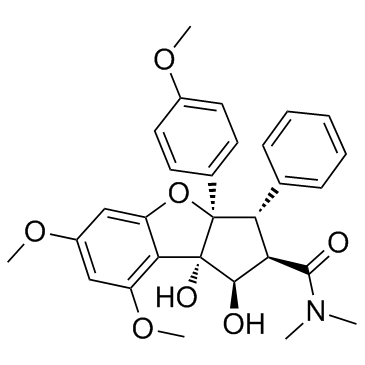楝酰胺

楝酰胺结构式

|
常用名 | 楝酰胺 | 英文名 | Rocaglamide |
|---|---|---|---|---|
| CAS号 | 84573-16-0 | 分子量 | 505.559 | |
| 密度 | 1.3±0.1 g/cm3 | 沸点 | 667.3±55.0 °C at 760 mmHg | |
| 分子式 | C29H31NO7 | 熔点 | N/A | |
| MSDS | 中文版 美版 | 闪点 | 357.4±31.5 °C |
|
Inhibitors of Translation Targeting Eukaryotic Translation Initiation Factor 4A-Chapter Twenty
Meth. Enzymol. 511 , 437-61, (2012) The RNA helicases eIF4AI and eIF4AII play key roles in recruiting ribosomes to mRNA templates during eukaryotic translation initiation. Small molecule inhibitors of eIF4AI and eIF4AII have been useful for chemically dissecting their role in translation in vit... |
|
|
Rocaglamide sensitizes leukemic T cells to activation-induced cell death by differential regulation of CD95L and c-FLIP expression.
Cell Death Differ. 16(9) , 1289-99, (2009) Drugs with tumor selectivity may have an important benefit in chemotherapies. We have previously shown that Rocaglamide(s), derived from the medicinal plant Aglaia, kills various leukemic cells through the mitochondrial apoptosis pathway with only minor toxic... |
|
|
Cyclorocaglamide, the first bridged cyclopentatetrahydrobenzofuran, and a related "open chain" rocaglamide derivative from Aglaia oligophylla.
J. Nat. Prod. 66(1) , 80-5, (2003) Two rocaglamide-related natural products, the previously known compound 6-demethoxy-10-hydroxy-11-methoxy-6,7-methylendioxyrocaglamide (3), and cyclorocaglamide (4), its 8b,10-anhydro analogue, have been isolated from the tropical plant Aglaia oligophylla. Co... |
|
|
Insecticidal rocaglamide derivatives from Aglaia spectabilis (Meliaceae).
Phytochemistry 54(8) , 731-6, (2000) Bark of Aglaia spectabilis collected on the island of Phu Quoc (Vietnam) yielded insecticidal cyclopentatetrahydrobenzofurans of the rocaglamide type including four new natural products. Structure elucidation of the new compounds is described. All rocaglamide... |
|
|
Rocaglamide and a XIAP inhibitor cooperatively sensitize TRAIL-mediated apoptosis in Hodgkin's lymphomas.
Int. J. Cancer 131(4) , 1003-8, (2012) Although most of the patients with Hodgkin's lymphoma (HL) can be cured by the current regimen of high-dose multiagent chemotherapy, the treatment causes high risks of later toxicities including secondary malignancies. Therefore, new rational strategies are n... |
|
|
Ponapensin, a cyclopenta[bc]benzopyran with potent NF-kappaB inhibitory activity from Aglaia ponapensis.
Bioorg. Med. Chem. Lett. 17(1) , 109-12, (2007) Two new compounds, a cyclopenta[bc]benzopyran, ponapensin (1), and an aglaialactone, 5,6-desmethylenedioxy-5-methoxy-aglalactone (2), together with nine known compounds were isolated from the CHCl(3) soluble extract of the leaves and twigs of Aglaia ponapensi... |
|
|
Rocaglamides, glycosides, and putrescine bisamides from Aglaia dasyclada.
J. Nat. Prod. 64(9) , 1216-20, (2001) A phytochemical analysis of the leaves of Aglaia dasyclada collected in Yunnan Province (People's Republic of China) yielded five cyclopentabenzofurans (1-5) of the rocaglamide family that are common secondary metabolites of Aglaia species as well as four bio... |
|
|
Potent cytotoxic rocaglamide derivatives from the fruits of Amoora cucullata.
Chem. Pharm. Bull. 54(9) , 1344-6, (2006) Two new rocaglamide derivatives, 1-O-formylrocagloic acid (1) and 3'-hydroxy rocagloic acid (2), together with five known compounds, rocaglaol (3), rocagloic acid (4), 3'-hydroxymethylrocaglate (5), 1-O-formylmethyl rocaglate (6), and methylrocaglate (7), wer... |
|
|
1H-cyclopenta[b]benzofuran lignans from Aglaia species inhibit cell proliferation and alter cell cycle distribution in human monocytic leukemia cell lines.
Z. Naturforsch., C, J. Biosci. 54(12) , 1075-83, (1999) Thirteen naturally occurring 1H-cyclopenta[b]benzofuran lignans of the rocaglamide type as well as one naturally occurring aglain congener all of them isolated from three Aglaia species (Aglaia duperreana, A. oligophylla and A. spectabilis) collected in Vietn... |
|
|
Cytotoxic rocaglamide derivatives from Aglaia duppereana.
Z. Naturforsch., C, J. Biosci. 68(7-8) , 269-74, (2013) Phytochemical investigation of Aglaia duppereana flowers led to the isolation of a new rocaglamide derivative and twelve known congeners. The structure of the new compound was unambiguously elucidated by spectroscopic techniques (1D- and 2D-NMR, HRESIMS). The... |